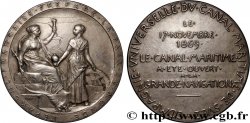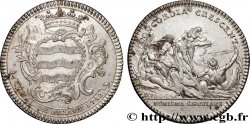fjt_1021571 - CANALS AND WATERWAY TRANSPORT Canal de Briare et Louis-Antoine de Pardaillan-Gondrin d’Antin 1742
80.00 €
Количество
Добавить в корзину

Тип Canal de Briare et Louis-Antoine de Pardaillan-Gondrin d’Antin
Дата: 1742
Металл: silver
Диаметр: 33,5 mm
Ориентация осей монеты: 6 h.
Вес: 15,76 g.
Век: cannelée
Пуансон: sans poinçon
Редкость: R1
Комментарии о состоянии
Taches d’oxydation et quelques concrétions. Faible usure
Ссылки в каталоге: :
Лицевая сторона
Аверс: легенда: CANAL DE BRIARE 1742.
Аверс: описание: Armes de Louis de Pardaillan de Gondrin d'Antin ; au-dessous sur une banderole :.
Обратная сторона
Реверс: легенда: CONCORDIA CRESCENT - À L'EXERGUE : NUMISMA SÆCULARE.
Реверс: Описание: Trois fleuves couchés renversant leurs urnes ; signature D.V. et date 1742 ; .
Реверс: перевод: (En confluant, ils grossissent).
Комментарий
Louis Antoine de Pardaillan de Gondrin, marquis de Montespan, marquis puis duc d’Antin (1665-1736) est le fils légitime de Louis-Henri de Pardaillan et de Françoise-Athénaïs de Rochechouart avant que celle-ci ne devienne la maîtresse du roi. Sa carrière militaire fut brillante, il est maréchal de camp en 1696 puis lieutenant général en 1703. En récompense de ses actions le roi le fait gouverneur d’Orléans et de l’Orléanais en 1707. Il succède à Mansart en 1708 à la surintendance des Bâtiments.
Le canal de Briare est un des plus anciens canaux de France et le premier de type canal à bief de partage.
Avec les cinquante-quatre kilomètres de son parcours et ses trente-huit écluses, en suivant principalement la vallée du Loing, il relie le canal du Loing, depuis le hameau de Buges dans le Loiret (non loin de Montargis), à la Loire et au Canal latéral à la Loire à Briare. Il permet à la navigation de relier les rivières de Loire et de Seine. C'est le prototype de tous les canaux modernes.
La suite à http://fr.wikipedia.org/wiki/Canal_de_Briare.
Louis Antoine de Pardaillan de Gondrin, Marquis de Montespan, Marquis then Duke of Antin (1665-1736) was the legitimate son of Louis-Henri de Pardaillan and Françoise-Athénaïs de Rochechouart before she became the king's mistress. He had a brilliant military career, becoming a field marshal in 1696 and then lieutenant general in 1703. As a reward for his actions, the king made him governor of Orléans and the Orléanais in 1707. He succeeded Mansart in 1708 as superintendant of buildings. The Briare Canal is one of the oldest canals in France and the first of the dividing-race canal type. With its fifty-four kilometers of course and its thirty-eight locks, mainly following the Loing Valley, it connects the Loing Canal, from the hamlet of Buges in Loiret (not far from Montargis), to the Loire and to the Canal latéral à la Loire at Briare. It allows navigation to connect the Loire and Seine rivers. It is the prototype of all modern canals. The rest at http://fr.wikipedia.org/wiki/Canal_de_Briare
Le canal de Briare est un des plus anciens canaux de France et le premier de type canal à bief de partage.
Avec les cinquante-quatre kilomètres de son parcours et ses trente-huit écluses, en suivant principalement la vallée du Loing, il relie le canal du Loing, depuis le hameau de Buges dans le Loiret (non loin de Montargis), à la Loire et au Canal latéral à la Loire à Briare. Il permet à la navigation de relier les rivières de Loire et de Seine. C'est le prototype de tous les canaux modernes.
La suite à http://fr.wikipedia.org/wiki/Canal_de_Briare.
Louis Antoine de Pardaillan de Gondrin, Marquis de Montespan, Marquis then Duke of Antin (1665-1736) was the legitimate son of Louis-Henri de Pardaillan and Françoise-Athénaïs de Rochechouart before she became the king's mistress. He had a brilliant military career, becoming a field marshal in 1696 and then lieutenant general in 1703. As a reward for his actions, the king made him governor of Orléans and the Orléanais in 1707. He succeeded Mansart in 1708 as superintendant of buildings. The Briare Canal is one of the oldest canals in France and the first of the dividing-race canal type. With its fifty-four kilometers of course and its thirty-eight locks, mainly following the Loing Valley, it connects the Loing Canal, from the hamlet of Buges in Loiret (not far from Montargis), to the Loire and to the Canal latéral à la Loire at Briare. It allows navigation to connect the Loire and Seine rivers. It is the prototype of all modern canals. The rest at http://fr.wikipedia.org/wiki/Canal_de_Briare








 Cообщить об ошибке
Cообщить об ошибке Распечатать страницу
Распечатать страницу Отправить мой выбор
Отправить мой выбор Задать вопрос
Задать вопрос Consign / sell
Consign / sell
 Информация
Информация










